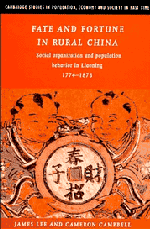Book contents
- Frontmatter
- Contents
- List of figures
- List of maps
- List of tables
- Acknowledgements
- PART 1 DAOYI VILLAGE
- PART 2 THE LIAONING DEMOGRAPHIC SYSTEM
- PART 3 HOUSEHOLD ORGANIZATION AND POPULATION BEHAVIOR
- PART 4 BANNER ORGANIZATION AND POPULATION BEHAVIOR
- EPILOGUE: PROSPECTS, IMPLICATIONS, AND COMPARISONS
- Appendices
- Glossary
- References
- Index
- Cambridge Studies in Population, Economy and Society in Past Time
PART 2 - THE LIAONING DEMOGRAPHIC SYSTEM
Published online by Cambridge University Press: 20 October 2009
- Frontmatter
- Contents
- List of figures
- List of maps
- List of tables
- Acknowledgements
- PART 1 DAOYI VILLAGE
- PART 2 THE LIAONING DEMOGRAPHIC SYSTEM
- PART 3 HOUSEHOLD ORGANIZATION AND POPULATION BEHAVIOR
- PART 4 BANNER ORGANIZATION AND POPULATION BEHAVIOR
- EPILOGUE: PROSPECTS, IMPLICATIONS, AND COMPARISONS
- Appendices
- Glossary
- References
- Index
- Cambridge Studies in Population, Economy and Society in Past Time
Summary
“May you live a hundred years and have many sons (changgming baisui; duozi duofu)”
(traditional Chinese proverb)In late imperial China, mortality and fertility represented the warp and weft of individual fate and fortune. Chinese conceived of their life span as a function of individual fate; and the number and sexual composition of their children as a consequence of personal fortune. Moreover, they regarded both as largely out of their personal control. Demographers, until recently, agreed with these sentiments. The conventional demographic wisdom, dating as far back as Malthus, was that mortality and marital fertility were beyond human control. Marriage, which Malthus called the preventive check, was the only means to control fertility. Mortality, which Malthus termed the positive check, was the only sure means to control population size. Infanticide was rare, and had little effect on the overall rate of growth. Fertility control within marriage was unknown.
In this conception, there were no conscious positive or preventive checks to population growth in the late imperial Chinese demographic system. Marriage was early and universal. In the absence of any preventive check, Chinese population size alternated between periods of sustained growth when no checks operated at all, and periods of disastrous contraction when nature responded by imposing her own positive checks: epidemics, famines, and war (Chao 1986; Elvin 1973; Ho 1959; Huang 1990; Perkins 1969).
There is increasing evidence, however, that this was not true in late imperial China. Recently discovered population records, among the most complete and accurate demographic data for any historic population, have begun to illuminate the population history of China before this century (Lee, Campbell, and Wang 1993).
- Type
- Chapter
- Information
- Fate and Fortune in Rural ChinaSocial Organization and Population Behavior in Liaoning 1774–1873, pp. 55 - 57Publisher: Cambridge University PressPrint publication year: 1997



